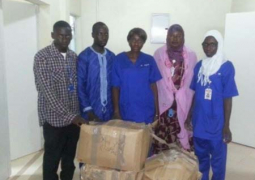
In The Gambia, sexually transmitted infections (STIs) remain a serious health problem, even though the most of these infections are absolutely preventable and can be cured.
National Condom Day originated from an AIDS support group in America during the late 1980’s, with the purpose of promoting condom use and educating people about the need to practise safe sex. Sexual and Reproductive Health Western Australia coordinates National Condom Day as an annual state-wide health initiative. The campaign falls on February 14, Valentine’s Day, an ideal opportunity to promote healthy relationships, and remind people about the risks of sexually transmissible infections (STIs) and unplanned pregnancies. National Condom Day is a timely reminder for people to always use condoms during sexual activity to protect themselves and their partner/s
You have to know what is the negative side of having sex with someone that you do not know. If you are not ready please do not do it, if you’re ready please just use a condom. Protect Against HPV and Are a Vital Complement to HPV
What are STIs (sexually transmitted infections)
Sexually transmitted infections (STIs) are infectious diseases that you can get by having sexual intercourse or contact with a sexual partner who has an STI.
Some of the more common symptoms of STIs are:
Discharge from the penis or vagina
Pain or stinging during sex or when urinating
Pain and swollen glands in the groin area
Painless red sores on the genital area, anus, tongue and throat
A scaly rash on the hands and soles of the feet
Warts around the area of the genitals
Small blisters that turn into scabs in the area of the genitals
Dark urine and loose, light coloured stools
· Yellow eyes and skin
Swollen glands, body aches and fevers
Weight loss and fatigur
How do you avoid getting an STI
The best way to avoid catching an STI is to not have sex at all but this is not a practical option.
Another way to avoid getting an STI is to commit to one sexual partner who has been tested and cleared for STIs.
One of the best means of protection against STIs is condoms. While they may not offer complete protection from STIs, they are most certainly the best means of prevention available.
Condoms need to be used every time you have sex to offer full protection against infection. Condoms also help prevent pregnancy. There are also female condoms available for women who have trouble getting their partners to use a condom.
A sexually transmitted infection, or STI, is a disease (bacteria, virus, or parasite) that is usually passed from one person to another through sexual activity. This does not necessarily have to include penetration, as some STIs are passed from skin to skin contact. How else can STIs be transmitted?
STIs can also be transmitted from mother to child during birth, blood transfusions, and from sharing needles in hypodermic syringes. STIs are a major health concern in South Africa, and over four million people receive treatment for STIs every year. However, many people are embarrassed by their conditions and do not report them to the doctor as they should. The different types of STIs • Chlamydia – Chlamydia is the most common bacterial STI.
Chlamydia can cause an infection with no symptoms in men, but often leads to severe infection in women. Left untreated, chlamydia can lead to infertility in women. • Genital warts – Genital warts appear as little bumps or growths in the genital and/ or anal area of your body. They are relatively easy to treat with various topical creams and a type of treatment called cryotherapy, which freezes the warts off.
Genital herpes – This is one of the most common STIs in South Africa. Herpes sufferers experience bursts of painful sores or blisters in the genital area from time to time. Many people do not realise just how serious herpes is. It is the leading cause of genital ulcer disease worldwide and also increases the risk of HIV transmission. • Gonorrhoea – Gonorrhoea is a bacterial infection. Symptoms of this STI include unusual discharge and painful urination.
It is easy to diagnose and treat. However, if left untreated it can cause serious health problems and even infertility. • Syphilis – Syphilis is one of the more complex STIs in terms of symptoms as it initially appears as a painless sore on the genital or around the mouth, which typically lasts for two to six weeks. It then causes an erratic skin rash and sore throat. It is fairly easy to treat, but can be extremely dangerous if left untreated. Long-term effects of syphilis include blindness, paralysis, stroke, and even death. • HIV – HIV is one of the more commonly known STIs and one of the most dangerous.
HIV wears down your immune system so that your body is unable to fight against other infections. While there is no cure for HIV, it can be successfully treated, enabling those who are HIV-positive to live long and fulfilling lives. STI/Condom Week is a health awareness event held between the 9th and 15th of February each year to highlight the importance of condom usage and inform people about the transmission of sexually transmitted infections.
How do I know if I have an STI?
The symptoms of an STI vary depending on the infection that has been contracted. Certain STIs may not even cause any symptoms at all, making it difficult for the sufferer to know that they have one. However, there are a number of symptoms that may point to an STI, including: • Pain during urination. • Sores and/or bumps in the oral, genital, or rectal areas. • Unusual vaginal discharge or bleeding. • Sore or swollen lymph nodes, or glands, in the groin area and sometimes elsewhere in the body. • Lower abdominal pain. How can you protect yourself?
You can reduce your chances of exposure to STIs in several ways: • Have sex with a partner who has been tested for an STI, and who only has sex with you. The more partners you have, the more likely you are to be exposed to an STI. • Having sex without a condom is one of the greatest causes of contracting STIs. It is vital that you use a condom at all times when having sexual intercourse. •
Previous infections with one or more STIs make it easier for a new STI to develop in your body. You and your partner can also re-infect one another with an STI if you do not get yourselves tested and treated regularly. • Always use sterile or new needles, and do not share drug-using equipment. Most STIs can be cured if diagnosed and treated early. All of them can be prevented, however, through responsible sexual behaviour.
Condoms and STIs Most experts believe that the risk of getting HIV & AIDS and other STIs can be greatly reduced if a condom is used properly. Consistent and correct use of male latex condoms can reduce (though not eliminate) the risk of STI transmission, and provide maximum protective support. Inconsistent use can lead to STI acquisition, because transmission can occur with a single act of intercourse with an infected partner. However, there’s no absolute guarantee even when you use a condom. Sexual health
The new study demonstrates condoms’ effectiveness at reducing women’s risk of HPV infection and contributes to the mounting scientific evidence of condoms’
Effectiveness at helping reduce sexually transmitted infections, including human immunodeficiency virus (HIV) infection, gonorrhoea and chlamydia, and herpes simplex virus in both women and men. While the U.S. Food and Drug Administration has recently approved a new vaccine to prevent human papilloma virus infections, which cause virtually all cervical cancers in women,* the HPV vaccine may not be universally or quickly available. Nor does it protect against all forms of HPV. So condoms are a vital complement to the vaccine in reducing risks of HPV.
* Persons who abstain from sexual intercourse or who are uninfected and mutually monogamous eliminate the risk of sexually transmitted infections.
* Persons who choose to be sexually active can be reassured that condom use can reduce the risk of most sexually transmitted infections.
* Like any other prevention tool, condoms work only when they are used. Consistent and correct use is essential for optimal risk reduction.
* Condom use is only one of a growing array of methods for reducing the risks associated with sexual activity and should be targeted to groups in which sexual exposure to infection is likely.
* When used consistently and correctly, condoms also reduce the risk of unintended pregnancy.
* Although more than 90 percent of HPV infections clear up on their own, persistent infection with certain HPV types causes nearly all cervical cancers, which are the second biggest cause of female cancer mortality worldwide. An estimated 240,000 deaths due to cervical cancer occur yearly.
For further information visit EFSTH, government Health centers throughout the country, number of NGO and Private Clinics, email to azadehhassan@yahoo.co.uk and text only to Dr Azadeh 002207774469/3774469 during working days from 3-6 pm.
Author DR AZADEH Senior Lecturer at the University of the Gambia, Senior Consultant in Obstetrics & Gynaecology, Clinical Director of Medicare Health services.



